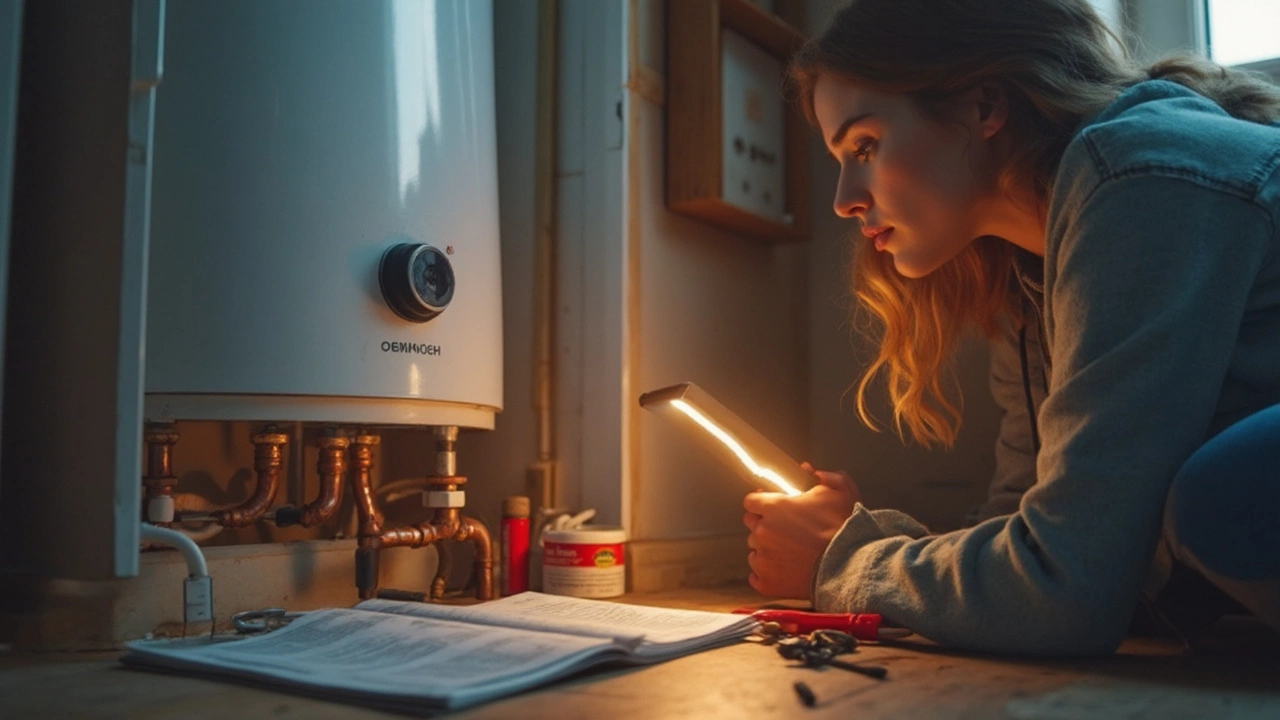Picture this: you’re bracing for your morning shower in the middle of a classic Auckland winter, you turn the tap—and get hit with water that's almost Antarctic. There’s nothing quite like being blasted by cold water to wake you up, but it’s not a thrill anyone’s looking for. If this sounds familiar, there’s a good chance your hot water heater element is throwing in the towel. Most people ignore the water heater until things get icy, but knowing how to spot the signs of a bad element—and what to do next—can save you from shivering and facing a big repair bill. You’d be surprised how much of your hot water blues link straight back to this one sneaky part.
Why Water Heater Elements Fail
Let’s get one thing straight: water heaters aren’t magic. They’re workhorses, plugging away for years, and sometimes their elements just give out. If you’ve got an electric water heater, there’s a heating element—or sometimes two—inside the tank. It’s basically a metal coil, kind of like what you see in an electric jug, but tucked out of sight. When you flick on the hot tap, power surges through the element and it heats the water. Simple, really. But over time, a few things can cause it to fail.
Scale is enemy number one. That white, chalky buildup you see on the shower head? It’s called limescale, and it loves to coat heating elements, especially around Auckland with our hard water. When the element gets coated in scale, it has to work harder to heat the water. Eventually, it overheats and snaps. It’s not just about age—sometimes elements burn out within a year in extra hard water areas.
Corrosion is another culprit. Most water heaters have what’s called a sacrificial anode, which sacrifices itself (hence the name) so the steel tank and its elements don’t rust. But if that anode’s gone ignored, corrosion sets in on the heater element itself, and you’re suddenly relying on a rusty bit of metal to heat your showers. Not ideal.
Other reasons? Power surges can short the element. Poor installation can mean the wrong element for your tank, or one that’s not tightened down, causing it to burn out quicker. Even simple things like constantly running out of hot water (because the thermostat’s set wrong) force the element to overwork, which wears it out far faster.
And here’s a quick myth-buster: elements don’t always last as long as your tank. Sure, you might get a good 8-12 years out of a quality water heater, but the elements themselves often need changing around the halfway mark. If you’ve never changed them, and you’re noticing colder showers? The element’s a top suspect.
Symptoms of a Bad Hot Water Heater Element
The clues are usually right in front of you—you just have to know what to look for. First up, if your hot water has gone completely cold, but you know the power is on, the main suspect is often a busted element.
Sometimes, it’s less dramatic. Maybe the water gets hot, but only for a few minutes, or it never feels as hot as it once did. This could mean one of the two heating elements is toast, especially in tanks with separate top and bottom elements. A dead lower element means you’ll get a small burst of hot water (from the upper section only), but it runs out fast.
If you’ve got discoloured water—brown or rusty—the heater element might be corroding. Likewise, a metallic taste to your water (rare, but possible) can mean metal parts inside are breaking down. In extreme cases, you might smell something odd, like a faint burning or electrical smell. That’s a warning sign the element is overheating or failing.
Strange noises can also tell the story. If you hear popping or hissing from the tank, it’s usually scale on the element boiling water underneath it. This doesn’t mean the element is dead yet, but it does say trouble is brewing.
A handy tip: hot water heater elements almost always fail silently. You won’t get dramatic sparks or big leaks—they just stop working. Your electric bill might even go up slightly, because the tank keeps trying to heat but never quite gets there.
Here’s a quick table to break down the classic symptoms versus other water heater problems, so you’re not chasing your tail on a wild goose chase:
| Symptom | Likely Problem |
|---|---|
| No hot water at all | Broken thermostat or both elements dead |
| Hot water runs out quickly | Lower element bad |
| Water never gets as hot | Element coated in limescale or single element failing |
| Discoloured or smelly water | Corrosion on element or inside tank |
| Strange noises (popping, hissing) | Element covered in scale |
The trickiest ones are intermittent issues—sometimes you get hot water, sometimes not. That can mean the element is on its last legs, or you’ve got a thermostat playing mind games. But if the power’s good, the circuit isn’t tripped, and only the water’s cold, bet your money on a bad element.

How to Test a Hot Water Heater Element
If you’re handy with basic tools and want to skip the plumber’s bill, there’s a proper way to confirm whether your heater element is shot.
First, safety. You need to switch off the circuit breaker for the water heater. These things run on 230V in New Zealand—no joke, you can get a nasty zap if you don’t cut the power. Double-check with a voltage tester on the wires before going near the element.
Here’s what you’ll need:
- Standard Phillips screwdriver
- Towel to mop up small leaks
- Multimeter (for checking continuity and resistance)
- Pliers (if needed)
- Replacement element if you confirm it’s faulty
Start by removing the metal cover plate on your heater tank. Underneath, there’s usually a small insulation pad—pull that aside, and you’ll see the electrical terminals for the element.
With the breaker OFF (did I say double check? Triple check), set your multimeter to the ohms (Ω) setting. Touch one probe to each terminal of the element (not the wires—unscrew those first to be sure you’re testing just the element). A good element should show a small but definite resistance number, usually between 10 and 20 ohms for most domestic water heaters. Got nothing, or infinite resistance? That’s a dead element. If the reading is way below 10, or it jumps around, that usually means the coil is cracked inside and shorting out.
Now, check for shorts. Put one probe on a terminal and the other on the metal base of the element. The meter should read infinity (no connection). If it reads zero or anything close to it, the element is shorted and needs replacing.
This DIY check takes less than 10 minutes and tells you for sure if the element’s your troublemaker. If it checks out, and you’re still short on hot water, it might be a thermostat issue instead. But honestly, 8 times out of 10 when the water stops heating and the tank’s fine, it’s the element.
Fun fact: Auckland’s water heaters mostly use screw-in style elements you can swap yourself if you’re feeling confident (just make sure to drain the tank first). If you’ve got the older flange style, it may take a bit more elbow grease, and sometimes it’s just easier to have a professional take over. Either way, knowing how to test the element puts you way ahead of most homeowners.
Fixing or Replacing a Faulty Water Heater Element
So you’ve found a dud element—what’s next? Replacing it isn’t rocket science, but there are a few things to watch for, especially if your tank’s seen better days. The first step is shutting off the power (seriously, make sure it’s off!) and turning off the water supply to the heater. Open a hot water tap to let air in, and drain the tank below the level of the element.
Use a proper element wrench or a sturdy spanner to loosen the old element. Expect some resistance, especially if scale has welded the threads in place. Once it’s free, you’ll probably see just how caked the inside gets—in some cases, you might even find bits of the broken coil rattling around inside the tank. Pull out the old gasket and toss it as well—never reuse the old seal.
For the new element, double check specs: make sure it’s the right wattage for your tank (NZ models usually run 2000-3000W). Smear a bit of plumber’s grease on the new gasket, thread it in snug, and tighten—no need to Hulk out, but it should feel really secure. Hook the wires back up exactly as they were, re-install the insulation and cover, and close the drain valve. Turn the water supply back on before powering up to avoid dry firing the new element.
Once the tank’s full and all air is bled from the taps, flip the breaker, and wait for a half hour. If you hear sizzling or see any leaks around the new install, cut the power immediately—something went sideways, and it’s better to double check than have a flood.
If things go smoothly, you’ll be back to steamy showers in no time. It’s a simple fix, but you’d be amazed how many old tanks are running way less efficiently because the elements are half-baked or sludged up. According to Kiwi plumbing suppliers, swapping a dead element can shave 10% or more off your hot water bill if the old one was struggling. And here’s a tip: pairing a new element with a tank flush every couple of years keeps that limescale at bay, extending the life of your heater (and avoiding that arctic blast in the a.m.).
If you’re nervous, there’s zero shame in calling a licensed plumber. Sometimes, stubborn elements just won’t budge, or you find the tank’s rusted out—both jobs for the pros. In Auckland, a straightforward element swap usually runs between $120-$250 NZD for parts and labour. DIYers can get the part for around $30-$60 NZD at major hardware chains, so it’s well worth a go if you’re handy and want to save a bit.
I can’t wrap without one final wisdom drop: don’t ignore your hot water heater. Give it a glance each year, and check those elements if the water’s feeling off. A simple fix today saves a cold headache tomorrow—and probably a fistful of dollars, too.


